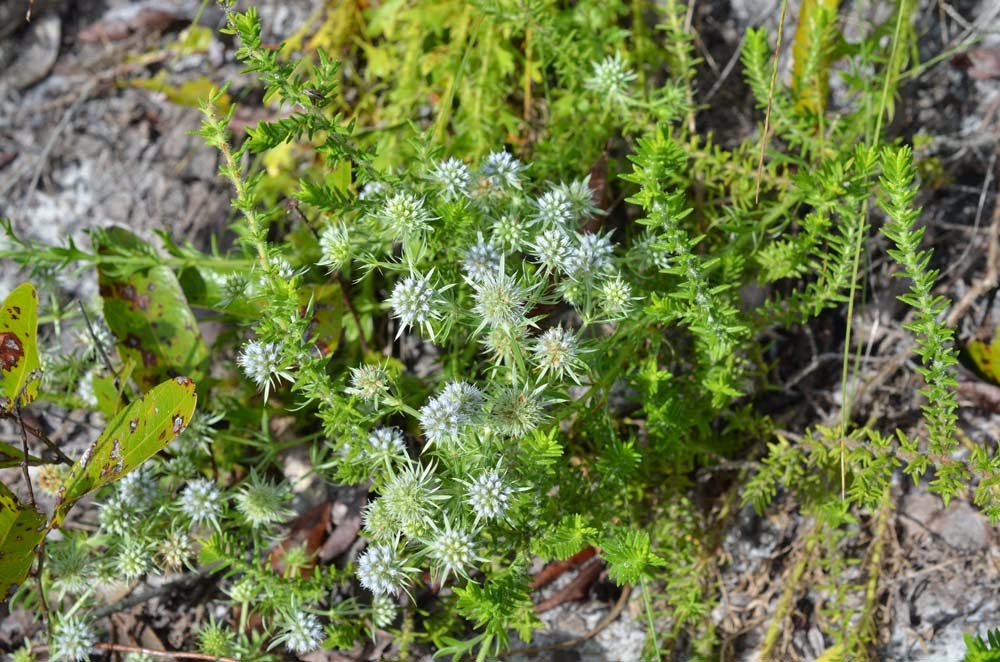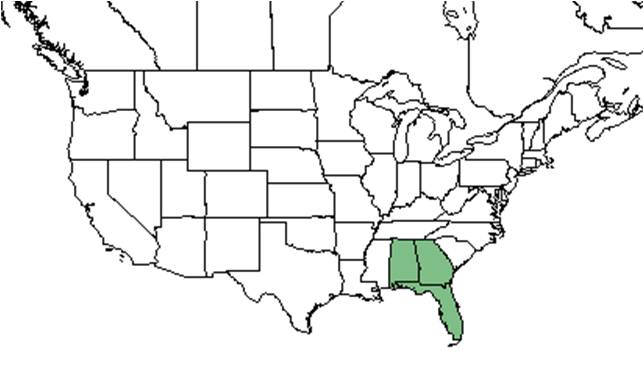Difference between revisions of "Eryngium aromaticum"
(→Pollination and use by animals) |
HaleighJoM (talk | contribs) (→Ecology) |
||
| Line 39: | Line 39: | ||
===Phenology=== <!--Timing off flowering, fruiting, seed dispersal, and environmental triggers. Cite PanFlora website if appropriate: http://www.gilnelson.com/PanFlora/ --> | ===Phenology=== <!--Timing off flowering, fruiting, seed dispersal, and environmental triggers. Cite PanFlora website if appropriate: http://www.gilnelson.com/PanFlora/ --> | ||
It produces thistle-shaped flowers arranged in umbels and achene fruit<ref name="Hortipedia"/>. It has been observed flowering and fruiting from June through December. <ref name="FSU Herbarium"/> | It produces thistle-shaped flowers arranged in umbels and achene fruit<ref name="Hortipedia"/>. It has been observed flowering and fruiting from June through December. <ref name="FSU Herbarium"/> | ||
| + | |||
<!--===Seed dispersal===--> | <!--===Seed dispersal===--> | ||
<!--===Seed bank and germination===--> | <!--===Seed bank and germination===--> | ||
<!--===Fire ecology===--> <!--Fire tolerance, fire dependence, adaptive fire responses--> | <!--===Fire ecology===--> <!--Fire tolerance, fire dependence, adaptive fire responses--> | ||
| − | ===Pollination | + | |
| − | ''Eryngium aromaticum'' is visited by sweat bees from the Halictidae family (''Lasioglossum placidensis''), thread-waisted wasps from the Sphecidae family (''Tachysphex similis''), and wasps from the Vespidae family (''Stenodynerus fundatiformis'').<ref name="Deyrup 2015">Deyrup, M.A. and N.D. 2015. Database of observations of Hymenoptera visitations to flowers of plants on Archbold Biological Station, Florida, USA.</ref> Additionally, ''E. aromaticum'' is used as larval food by the Eastern black swallowtail butterfly<ref name="Native"/>. | + | ===Pollination=== |
| + | ''Eryngium aromaticum'' is visited by sweat bees from the Halictidae family (''Lasioglossum placidensis''), thread-waisted wasps from the Sphecidae family (''Tachysphex similis''), and wasps from the Vespidae family (''Stenodynerus fundatiformis'').<ref name="Deyrup 2015">Deyrup, M.A. and N.D. 2015. Database of observations of Hymenoptera visitations to flowers of plants on Archbold Biological Station, Florida, USA.</ref> | ||
| + | |||
| + | ===Herbivory and toxicology=== | ||
| + | Additionally, ''E. aromaticum'' is used as larval food by the Eastern black swallowtail butterfly<ref name="Native"/>. | ||
| + | |||
<!--===Diseases and parasites===--> | <!--===Diseases and parasites===--> | ||
Revision as of 12:21, 30 June 2022
| Eryngium aromaticum | |
|---|---|

| |
| Photo by Wayne Matchett, SpaceCoastWildflowers.com | |
| Scientific classification | |
| Kingdom: | Plantae |
| Division: | Magnoliophyta - Flowering plants |
| Class: | Magnoliopsida - Dicotyledons |
| Order: | Apiales |
| Family: | Apiaceae ⁄ Umbelliferae |
| Genus: | Eryngium |
| Species: | E. aromaticum |
| Binomial name | |
| Eryngium aromaticum Baldw. | |

| |
| Natural range of Eryngium aromaticum from USDA NRCS Plants Database. | |
Common name: Fragrant eryngo
Contents
Taxonomic notes
Synonyms: none.[1]
Varieties: none.[1]
Description
E. aromaticum is a low growing, perennial herb that can be found as a basal rosette of slightly spiny, deeply dissected leaves through out most of the year. It has a carrot like taproot.[2] Leaves are simple and alternate.[3]
Distribution
It is found throughout the peninsula and panhandle of Florida, along with parts of eastern Georgia and southern Alabama.[2]
Ecology
Habitat
E. aromaticum has been found in loamy sand and peaty sand type habitats such as scrub, sand ridges, sandhills, flatwoods, open pinewoods, pine-oak woodland, and slash pine savannah. It is also found in disturbed areas including powerline corridors, disturbed slash pine forests, roadsides, and clear cut flatwood forests.[4]
E. aromaticum was found to increase in frequency in response to soil disturbance by clearcutting and chopping in north Florida flatwoods. It has shown regrowth in reestablished native flatwood habitat that was disturbed by these practices.[5] Associated species: Agalinis plukenetii, Liatris provincialis, Chrysopsis gossypina, C. linearifolia, Polygonella gracile, P. polygoma, P. fimbriata, Aristida stricta, Pinus clausa, Pinus palustris, Quercus virginiana, Quercus laevis, and Serenoa repens.[4]
Phenology
It produces thistle-shaped flowers arranged in umbels and achene fruit[3]. It has been observed flowering and fruiting from June through December. [4]
Pollination
Eryngium aromaticum is visited by sweat bees from the Halictidae family (Lasioglossum placidensis), thread-waisted wasps from the Sphecidae family (Tachysphex similis), and wasps from the Vespidae family (Stenodynerus fundatiformis).[6]
Herbivory and toxicology
Additionally, E. aromaticum is used as larval food by the Eastern black swallowtail butterfly[2].
Conservation, cultivation, and restoration
Cultural use
Photo Gallery
References and notes
- ↑ 1.0 1.1 Weakley, A.S. 2015. Flora of the southern and mid-atlantic states. Working Draft of 21 May 2015. University of North Carolina at Chapel Hill, Chapel Hill, North Carolina.
- ↑ 2.0 2.1 2.2 [Native Florida Wildflowers]Accessed: December 7, 2015
- ↑ 3.0 3.1 [Hortipedia]Accessed: December 7, 2015
- ↑ 4.0 4.1 4.2 Florida State University Robert K. Godfrey Herbarium database. URL: http://herbarium.bio.fsu.edu. Last accessed: May 2021. Collectors: Loran C. Anderson, Tara Baridi, C.H. Beck, George R. Cooley, D.S. Correll, R.J. Eaton, Rex Ellis, William B. Fox, R.K. Godfrey, R. Kral, O. Lakela, Robert L. Lazor, Sidney McDaniel, Marc Minno, Paul O. Schallert, Cecil Slaughter, R.F. Thorne, and D.B. Ward. States and Counties: Florida: Baker, Brevard, Broward, Charlotte, Citrus, Clay, Collier, Duval, Franklin, Highlands, Lee, Martin, Nassau, Okeechobee, Osceola, Putnam, Seminole, St. Johns, and Taylor.
- ↑ Moore, W.H., B.F. Swindel, and W.S. Terry. (1982). Vegetative Response to Clearcutting and Chopping in a North Florida Flatwoods Forest. Journal of Range Management 35(2):214-218.
- ↑ Deyrup, M.A. and N.D. 2015. Database of observations of Hymenoptera visitations to flowers of plants on Archbold Biological Station, Florida, USA.